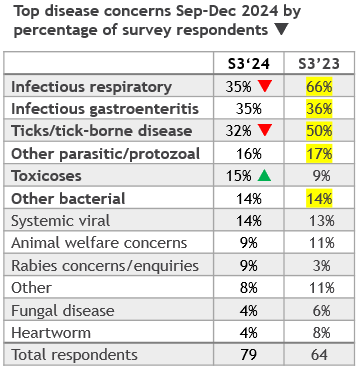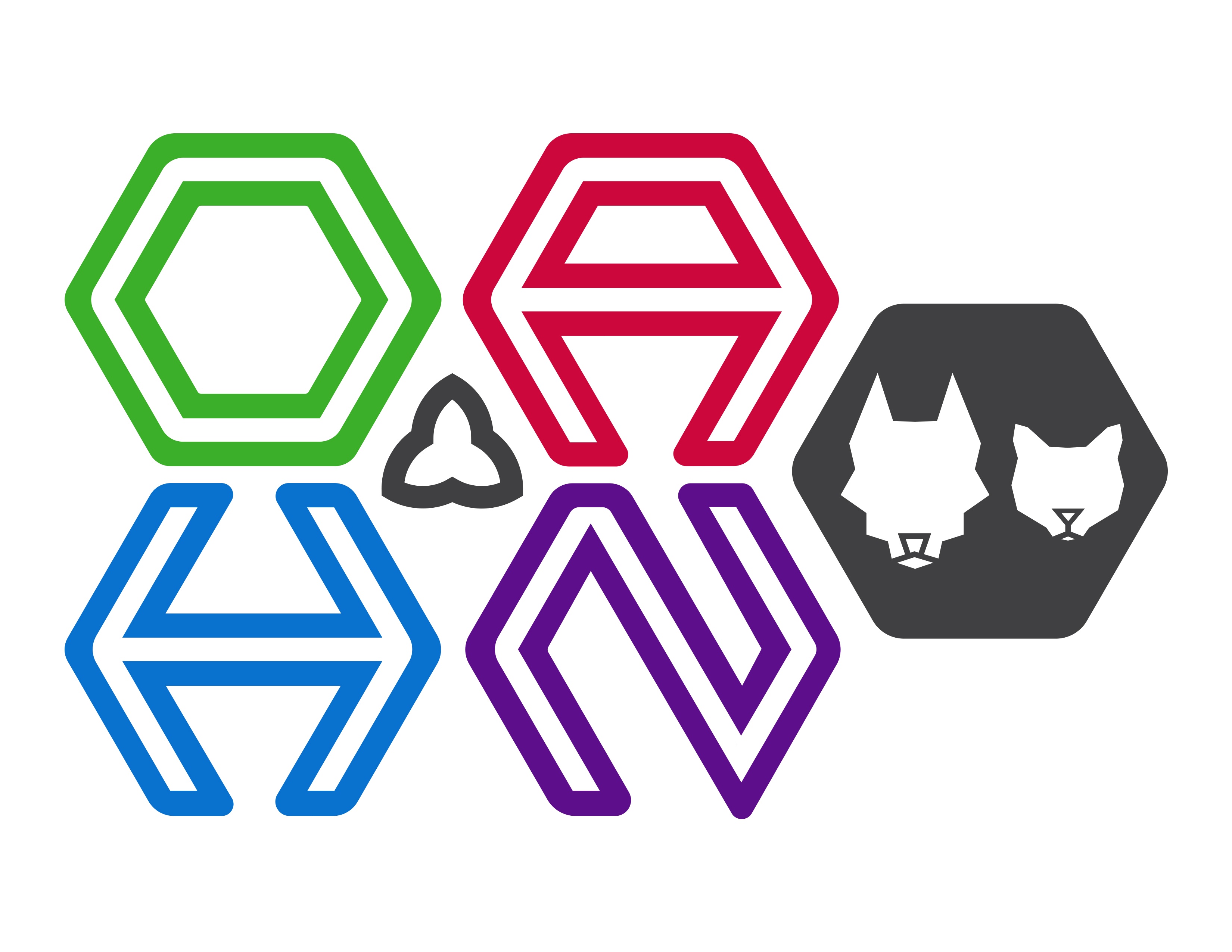Ontario Animal Health Network (OAHN)
Companion Animal Network Team
Veterinary Need-2-Know (N2K) Update – Sep-Dec 2024
OAHN winter survey and lab data: Key results
There were 79 survey respondents from 32 counties, including primary care, referral, and emergency practices. Overall it was a relatively quiet end to 2024 in terms of infectious diseases, with comments commonly about routine seasonal cases of canine respiratory disease, but far less than was seen during the broader “outbreak” in mid-to-late 2023. Parvovirus cases were also reported in not unexpected numbers, including some smaller outbreaks. In December, OAHN sent out an update about a larger parvo outbreak at a housing complex in Windsor ON.  It was reported at the time that a number of infected dogs had initially tested negative on point-of-care tests, but were later confirmed positive on PCR. This was similar to what happened during a parvo outbreak in Michigan in 2022. OAHN also provided a Need-2-Know factsheet on parvovirus tailored to dog owners in this and similar communities, with an emphasis on prevention, control and vaccination.
It was reported at the time that a number of infected dogs had initially tested negative on point-of-care tests, but were later confirmed positive on PCR. This was similar to what happened during a parvo outbreak in Michigan in 2022. OAHN also provided a Need-2-Know factsheet on parvovirus tailored to dog owners in this and similar communities, with an emphasis on prevention, control and vaccination.
Starts with a B…
In early December, a practitioner reported a peculiar case of a swollen testicle in a 7 month old poodle cross. The dog tested negative for Brucella canis, but following bilateral orchiectomy, histopathology confirmed Blastomyces in the one affected testicle. Urine antigen testing was later also found to be positive for Blastomyces. The dog had never travelled outside of eastern Ontario. The dog is being treated with itraconazole as a precaution since the diagnosis and has had no other signs of illness.
H5N1 avian influenza on the rise: More cows, more cats, raw milk / meat risks
The ongoing outbreak of H5N1 influenza A in dairy cattle in the US has now affected at least 16 states, with over 75% of the affected dairy herds located in California. Unlike Ontario, sale of raw unpasteurized milk for human consumption is allowed in some states, including California, which has resulted in a food safety hazard for both people and pets. A least 5 cats in California were confirmed to have died from H5N1 influenza after drinking recalled raw milk. The death of one cat in Oregon from H5N1 influenza was linked to consumption of a commercial raw meat diet that was found to contain the same strain of the virus, triggering a recall (none of the affected lots were sold in Canada). The virus has been confirmed in at least one other raw diet linked to the death of more cats in California. Raw diets also pose many other infectious disease risks to people and pets.
There has also been a dramatic increase in human cases of H5N1 influenza in the last year, primarily in the US. Part of this is also likely due to increased surveillance. Almost all the cases were associated with close contact with infected (or presumed infected) poultry or dairy cattle, and fortunately most of the cases have been mild. In a small number of cases the source of the virus was not identified, and there have been at least two cases of severe disease (one in the US and one in Canada). Intense investigation has not shown any evidence of human-to-human spread, but the concern is the more mammalian infections occur, the more opportunity there is for the virus to adapt to and become a greater risk to people and other mammals.
Cats, including domestic cats and big cats, appear to be particularly susceptible to the currently circulating strains of H5N1 influenza. Veterinarians are encouraged to keep H5N1 infection in mind for any cat presenting with severe acute neurological or respiratory signs or sudden death, especially (but not exclusively) if they have potential contact with other infected animals in the area (e.g. birds, cattle, rodents) or potentially contaminated raw meat or raw milk.
OAHN is developing a quick reference for influenza A testing options for domestic animals in Ontario (including pets) which will be released soon.
Advice for Ontario veterinarians:
- Encourage owners to avoid contact between pets and potentially infected wildlife (especially birds)
- Ask screening questions for sick pets
- Outdoor / wild bird exposure
- Raw milk / raw diet exposure
- Reinforce routine precautions for potentially infectious patients (i.e. gloves, lab coat, hand hygiene, segregation)
- Use enhanced precautions in suspect cases
- N95 respirator, face/eye protection
- Promote testing in suspect cases
- Check with your lab to confirm they can identify H5 influenza strains
- Testing is available for eligible cats through the OAHN AIV in feral cats surveillance project.
Rabies update
In Ontario, 2024 was the first year with no raccoon-variant rabies cases detected since the latest outbreak began in 2015. As of July 1, all cases will be considered “expired” (over 2 years old), but the MNR rabies baiting and control zones will remain largely unchanged for at least another year, barring more cases. Cases continue to be detected along the border with New York State and other parts of New England, so it is still important to remain vigilant.
However, it was also a record year for bat-variant rabies cases, with 90 positive bats detected across the province (compared to 49 in 2023). A new infographic about rabies in bats was released by PHAC, and OAHN’s N2K: Bats in Ontario resource is also available.
OMAFA’s rabies response request form is the best way for veterinarians to reach OMAFA for assistance with risk assessments, sample submission and post-exposure management guidance for domestic animals. The form has recently been moved to a new platform, so be sure to update any saved bookmarks! Find the form at www.ontario.ca/rabiesrequest. For more resources, see OMAFA’s latest veterinary advisory on rabies in Ontario.
Hepatozoon canis in a dog, Eastern ON
In December, a dog in Eastern Ontario with no significant travel history was presented for anorexia, malaise, fever and GI upset. The dog had mild anemia, marked neutrophilia, and was diagnosed with Hepatozoon canis infection based on blood PCR. Sadly the dog passed away shortly after starting treatment. This case is unusual because H. canis is transmitted by R. sanguineus ticks, which are not endemic in Ontario but are associated with imported dogs (and they can establish infestations indoors with only dogs for hosts). While H. canis is found in parts of the US and tropical regions, there is no known reservoir in Canada. An unidentified tick that was positive for H. canis was pulled off this dog in October, but the protozoa is transmitted by ingestion of an infected tick, so the dog must have encountered and swallowed at least one other such tick. This emphasizes the importance of querying travel history and contact with other dogs that have travelled, and always identifying ticks from pets.
FIP drugs update
A Canadian pharmacy (Trutina Pharmacy) is now producing GS-441524, in collaboration with BOVA, the UK pharmacy from which Canadian veterinarians have been importing this drug with EDR approval since early 2024. This means GS-441524 can now be ordered and stocked like most other drugs, making access much quicker and easier. Check out the OAHN podcast: FIP treatments (and where to find them) with special guest Dr. Kelly St. Denis for tips on diagnosing and treating this otherwise deadly disease.
GI antimicrobial use guidelines published
The long-awaited guidelines for antimicrobial use in canine acute diarrhea from the European Network for Optimization of Veterinary Antimicrobial Therapy (ENOVAT) are now freely available online in (Jessen et al. 2024). They provide strong evidence-based recommendations against use of antimicrobials in dogs with mild to moderate diarrhea. Consult the complete guidelines for more details!
Small flock sheep and goat course for vets
CAHSS is offering this virtual RACE-approved course for veterinarians for FREE from Jan 21 – Feb 25 (6 sessions). If you see (or might see) small numbers of sheep or goats and need some tips or a refresher, click here to register! Sessions will also be recorded.
RHD update webinar
Rabbit hemorrhagic disease (RHD) has not been reported in Ontario since 2022, although cases were detected in domestic rabbits in Quebec in 2023 and 2024. The causative virus, also known as Lagovirus europaeus/GI.1 and GI.2, is immediately notifiable to OMAFA in Ontario. A recent webinar hosted by CAHSS, now available online, provides an excellent summary of the current situation with RHD across Canada and the US, and important information and advice on handling suspect cases. At this time, the OAHN wildlife and companion animal networks continue to offer heavily subsidized RHDV2 testing for wild and domestic rabbits. For more details and eligibility, please contact Dr. Alexandra Reid via email, or via the OMAFA AICC at 877-424-1300 during business hours.
Help us help you!
Have an idea for an infographic you’d like to see, or a podcast you’d like to hear? Email oahn@uoguelph.ca to let us know!


